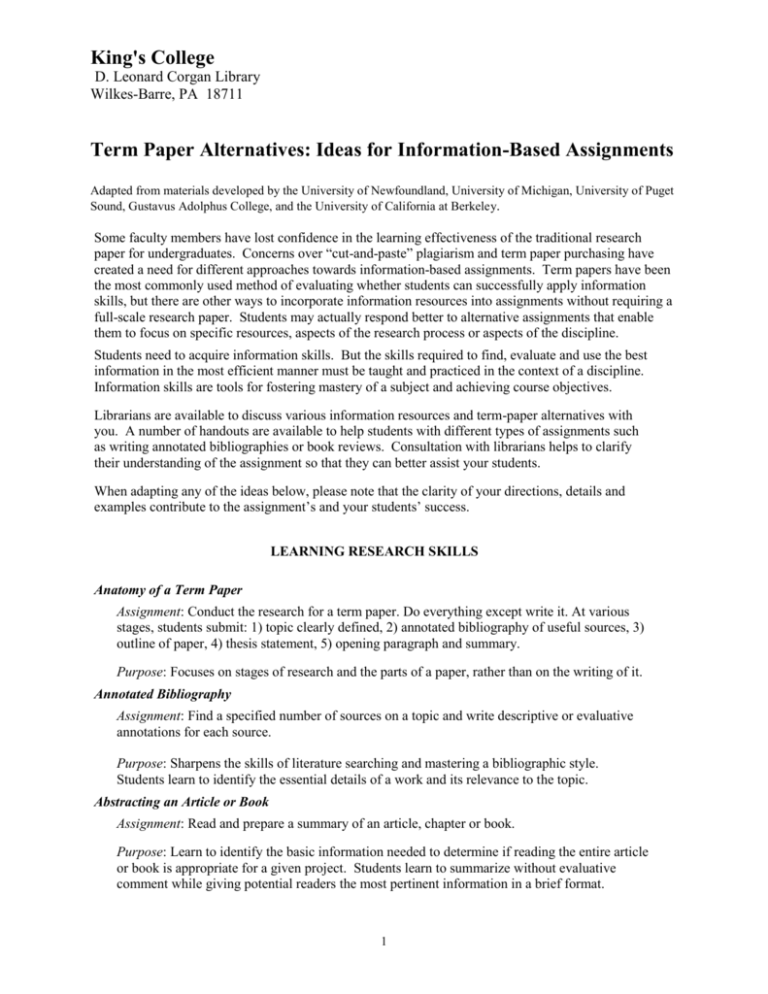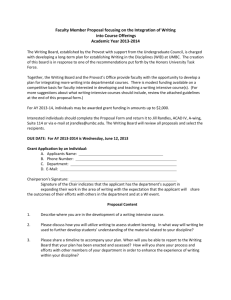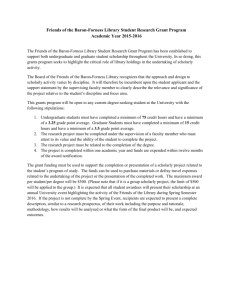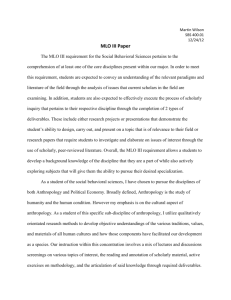Term Paper Alternatives
advertisement

King's College D. Leonard Corgan Library Wilkes-Barre, PA 18711 Term Paper Alternatives: Ideas for Information-Based Assignments Adapted from materials developed by the University of Newfoundland, University of Michigan, University of Puget Sound, Gustavus Adolphus College, and the University of California at Berkeley. Some faculty members have lost confidence in the learning effectiveness of the traditional research paper for undergraduates. Concerns over “cut-and-paste” plagiarism and term paper purchasing have created a need for different approaches towards information-based assignments. Term papers have been the most commonly used method of evaluating whether students can successfully apply information skills, but there are other ways to incorporate information resources into assignments without requiring a full-scale research paper. Students may actually respond better to alternative assignments that enable them to focus on specific resources, aspects of the research process or aspects of the discipline. Students need to acquire information skills. But the skills required to find, evaluate and use the best information in the most efficient manner must be taught and practiced in the context of a discipline. Information skills are tools for fostering mastery of a subject and achieving course objectives. Librarians are available to discuss various information resources and term-paper alternatives with you. A number of handouts are available to help students with different types of assignments such as writing annotated bibliographies or book reviews. Consultation with librarians helps to clarify their understanding of the assignment so that they can better assist your students. When adapting any of the ideas below, please note that the clarity of your directions, details and examples contribute to the assignment’s and your students’ success. LEARNING RESEARCH SKILLS Anatomy of a Term Paper Assignment: Conduct the research for a term paper. Do everything except write it. At various stages, students submit: 1) topic clearly defined, 2) annotated bibliography of useful sources, 3) outline of paper, 4) thesis statement, 5) opening paragraph and summary. Purpose: Focuses on stages of research and the parts of a paper, rather than on the writing of it. Annotated Bibliography Assignment: Find a specified number of sources on a topic and write descriptive or evaluative annotations for each source. Purpose: Sharpens the skills of literature searching and mastering a bibliographic style. Students learn to identify the essential details of a work and its relevance to the topic. Abstracting an Article or Book Assignment: Read and prepare a summary of an article, chapter or book. Purpose: Learn to identify the basic information needed to determine if reading the entire article or book is appropriate for a given project. Students learn to summarize without evaluative comment while giving potential readers the most pertinent information in a brief format. 1 Compare Internet and Database Searches Assignment: Provide a precise statement of the search topic. Run the search on the Web (try more than one search engine) and on a database (Academic Search Premier, Lexis-Nexis, Criminal Justice Periodical Index, etc). Students will need instruction in the basic concepts of database searching, such as using Boolean operators and selecting effective search terms. Present some representation of the search results and compare the findings. Was one source better than the other? If so, why and how? Justify the choice of databases. Purpose: Demonstrates the differences between these searches with respect to content and search strategy. Teaches students that Internet access is not just one thing and that Web searching is not the same as database searching. Database Comparison Assignment: Assign a research topic in two online databases (such as one interdisciplinary and one specialized, or the online catalog and one journal database). Compare and contrast the databases, noting differences in purpose, subjects covered, types of resources indexed, availability of full text, etc. Comment on the usefulness of each database (or catalog) in providing information on your particular topic. Purpose: This assignment familiarizes the students with the databases and/or the catalog available to them for locating and retrieving relevant and timely materials. Comparison of Information Sources Assignment: Select a topic and compare how that topic is treated in two to five different types of sources, such as journals, magazines, newspapers, encyclopedias, Internet, and books. Purpose: The student becomes aware of the characteristics and usefulness of a variety of information sources. Variation: Use an index to locate two articles that present differing viewpoints, such as scholarly/popular or conservative/liberal. Identify the similarities and differences, and provide reasons for the differing opinions. Purpose: Reveals that most journals appeal to a defined constituency and that their reporting and editorial policies reflect the attitudes of that constituency. Literature Review Assignment: Review the literature on a specific topic for a given time period. Purpose: Reveals the purpose of a literature review, and provides experience doing one. Students must identify appropriate articles and use them to describe the current thinking or research on a topic. Update a Bibliography or Review Article Assignment: Select (or assign) a bibliography or review article written a number of years ago and update that bibliography or review article. Explain briefly why the new publications were chosen. Purpose: Introduces students to literature reviews and reference sources. Provides practice in searching for up-to-date information from various sources. Requires students to analyze, synthesize and integrate the ideas they find utilizing critical thinking and evaluative skills. 2 Create an Anthology Assignment: Compile an anthology of readings by one person or on one topic. A model for this format is an annotated book of readings, like those frequently used for college courses. Include an introduction that displays an overall understanding of the subject and gives biographical information about the authors. Explain the rationale for including the works. Include reviews or critical materials to justify the choices. Purpose: Encourages critical reading and evaluation. Requires the student to identify similarities and differences between articles and to relate various writings to a common theme. How Conditions Have Changed Assignment: Compare and contrast an economic or social condition from XX years ago with the current situation. Use reports, statistics, and articles to describe each era and support your response. Purpose: This assignment develops a student’s ability to use a variety of resources and to compare and critically evaluate the findings. Scholarly Analysis of an Event in History Assignment: What was the popular press saying about a political event/scientific study/societal change at the time it was occurring? How is it now discussed in the scholarly literature? Read and summarize the main points of 2-3 popular articles written during the event, and contrast them with contemporary scholarly analysis. Purpose: Using a variety of sources, students develop the capacity to relate the past to the present and the ability to place current events within a historical context. Research a News Item Assignment: Have students find a reference to a study in a popular magazine, such as Time, Newsweek, Psychology Today, or Life. (Look for a phrase such as, “According to a study….”) Then have them locate the original research or the actual study in a scholarly journal. Compare the authorship, content, format, and the conclusions of the two articles. Purpose: This assignment highlights the distinction between popular and scholarly sources, and between primary and secondary sources. It also helps the students understand the differences in the audience and level of authority. Corporate Event Assignment: Identify a corporate event (IPO, spin-off, merger, major new product introduction, etc.) and examine the stock price reaction to the published disclosure of the event. Students must provide an accurate assessment of the consequences of the transaction on the company’s common stock. Students produce a report which incorporates graphs/charts pertaining to the assigned company, as well as research from five or more firms that undertook the same corporate event and examine the market reaction to the public announcement. Purpose: This assignment requires the students to use resources in the discipline to gather information for practical purposes. 3 Poster Session Assignment: Research a topic and present it as a poster that other students will use to learn about the topic. Purpose: Gives the opportunity to conduct a search and requires students to express the important points succinctly. UNDERSTANDING THE STRUCTURE OF "THE LITERATURE" Understanding "The Literature" of a Discipline Assignment: What does "the literature" of a discipline look like? What comprises it? How is it produced, disseminated and accessed in a given discipline? How is the knowledge produced? By whom? In which media is it presented? What is the publishing cycle? How important is informal communication in the field? Purpose: Demystifies the elusive term "the literature" and provides students with an understanding of the mechanisms, organization and structure of the literature in a given field. Examining a Classical Work Assignment: Explore through book reviews, biographical information, and indexes how and why a work becomes a "classic." What effect does a classical work have on a discipline? Purpose: Demonstrates the evolution of ideas and identifies factors that make a work "important." Following Research Trends Assignment: Select a present day issue or concern. Search the past literature at 5 or 10-year intervals. How have theories or attitudes toward the issue changed? Purpose: Demonstrates that the problems and concerns of humankind have not really changed through the years. What have changed are our attitudes and understandings of these concerns. Illustrates the explosion of research and how its issues, content and methods change. Forecasting in Retrospect Assignment: What did articles written in the [1960s] predict about the future of [computers]. Did the forecasts come true or not? Why? Purpose: Demonstrates the importance of historical perspective and how unexamined assumptions and other variables can produce unexpected results. Tracing a Scholar's Career Assignment: Students choose (or are assigned) a scholar/researcher. Explore that person's career and ideas by locating biographical information, preparing a bibliography of the scholar’s writings, analyzing the reaction of the scholarly community to the researcher's work, and examining the scholarly network in which the scholar works. Purpose: Introduces students to the use of biographical and bibliographical tools, and exposes them to examples of scholarly dialogue. 4 Important People in a Discipline Assignment: Part 1: Identify important people in a discipline. Have students consult a variety of biographical sources and subject encyclopedias to gain a broader appreciation for the context in which important accomplishments were achieved. Have students write a paper discussing the essence of the individual’s life. Student will compile a short bibliography of sources consulted for the paper. Purpose: Students develop research skills and become acquainted with a variety of reference works as they learn the personalities and history of the discipline. Identifying Major Journals Assignment: Identify (with professor's help) major journals in the discipline. Compare and contrast them. Analyze their content, tone, audience, and impact. Purpose: Emphasizes the importance of journal literature. Makes the point that journals differ in approach and perspective. Understanding Primary Sources Assignment: Compare and contrast primary and secondary sources on the same topic. Note the similarities and differences in their content, purpose, audience, and treatment of the topic. Purpose: Teaches students to differentiate between primary/secondary sources in a discipline. Shows when and why to use each. Compare and Contrast Sources Assignment: Locate a popular magazine article; then find a scholarly article on the same subject. Compare the two articles for content, style, bias, audience, etc. Purpose: Demonstrates the characteristics of various types of sources and develops evaluative skills. Dissecting a Scholarly Article Assignment: Select an article from a scholarly journal (pertaining to a specific discipline). Get the instructor’s approval. Prepare a 4 to 6 page article review, providing an introduction to the topic of the article, the issue being discussed, the hypothesis being studied, the sample (random/non-random and size), the methods used, major findings, and conclusions (adding opinions, views, clarifications, or claims regarding the research). Attach the article to your critique. Purpose: The students develop an appreciation for research and scholarship in a given discipline. They also are introduced to the process of analyzing and evaluating a scholarly journal article. Autobiography and Secondary Sources Assignment: Choose an autobiography of someone related to the course content. Find secondary sources which deal with an idea or event described in the autobiography. Compare and contrast the sources. Purpose: Demonstrates how secondary sources include interpretation and analysis of events described in a primary source. 5 Simulations of Real-Life Projects Assignment: Prepare a grant or research proposal, marketing or business plan, or solution to a tax, accounting, or financial problem. State the specific problem to be solved or task to be accomplished. Provide background on the problem. How have these issues been dealt with in the past? What is the current thinking on this issue? How do you propose to solve the problem, or what are the questions you need to ask to solve the problem? What support can you offer for your solution? Purpose: Simulates for students how they will apply their information skills in the context of problems they will encounter in their discipline or career. Research a Company, Organization, or Prospective Professor Assignment: Assemble background information on a company or organization in preparation for a hypothetical interview. For those continuing in academia, research prospective colleagues' or professors' backgrounds, publications, current research, etc. Purpose: Develops critical thinking and skill in using resources to research companies or individuals and their contributions. Create an Interview Assignment: Have the class prepare an interview—either one to be actually carried out or one that they can’t because the subject is long dead or otherwise unavailable. To generate useful questions they would have to become familiar with the person’s life and work and understand its significance. They could either write up results of a real interview or write their own imaginary responses based on available evidence. Purpose: Develops the student’s ability to search for information about an individual in a chosen discipline, and requires that the student think critically about the person’s work and contribution to the field. Investigation of a Disease and Prescribed Treatment Assignment: In biology or health classes, assign each student a 'diagnosis'. Have them act as responsible patients by investigating both the diagnosis and the prescribed treatment. Results presented in a two-page paper should cover: a description of the condition and its symptoms; its etiology; its prognosis; the effectiveness of the prescribed treatment, its side effects and contradictions, along with the evidence; and, finally, a comparison of the relative effectiveness of alternate treatments. This can also be accompanied by oral or visual presentations, slideshow, poster session, etc. Purpose: Teaches the application of information in print to real-life situations. Acquaints students with medical literature. CRITICAL READING Look Behind the Book Assignment: Examine the credibility of a major monograph in the field. Who wrote it? What are the author's credentials? What is the point of view of the book? Find three reviews of it and compare them. Suggest comparable works (with reasons). Purpose: Emphasizes that ideas and people have contexts. 6 Analyze the Argument Assignment: Read an editorial and find facts to support or refute it. Cite sources. Purpose: Encourages critical reading and develops research skills. Provides practice in applying principles of citation style. Evaluate a Research Report Assignment: Examine the experimental design, data, and interpretation of the data in a research paper for adequacy and consistency. [Professor may want to hand out questions, to pinpoint specific aspects of the article]. Purpose: Focuses on the critical evaluation of research. Compare Book Reviews Assignment: Locate and read three or four reviews of a work. Compare and contrast the reviews. Comment on the viewpoints, biases, or assumptions that the reviewers exhibit. Purpose: Encourages students to think critically about an author’s point of view. Provides insight to the importance of critical reception. Distinguishing Between Credible and Non-Credible Sources Assignment: Students find an article in National Enquirer or similar publication (with faculty approval). Research the issue in an attempt to support or refute the claims made. Search online databases, the catalog, or the Internet. Indicate what evidence you uncovered, and from what source. Document your research – both what you were able to find and not able to find. Purpose: Students learn to critically analyze claims and to question the credibility of sources. Viewpoint of a Culture/Country Assignment: Students find journal, magazine, or newspaper articles representing views on an event or topic from different cultures or countries. Then they compare and contrast the various views. Purpose: Analyzing differing cultural perspectives on issues encourages students to understand that multiple perspectives of an issue are in operation at the same time. This analysis will help students to broaden and enhance their own perspectives on these issues. Evaluate a Psychological Test Assignment: Determine the adequacy of several psychological tests based on the literature. Using the information you gather, develop a test battery designed for a clinical situation. Purpose: Students develop research and analysis skills and become acquainted with the test literature. 7 Write a Book or Film Review Assignment: Review a book/film (either of the students' choice or one assigned to them). What is the author’s thesis? Identify the author’s main ideas and how they are developed. Discuss the author's credentials. Compare the book/film to similar works in the field. A film can also be compared to its source, e.g. a book or a play. Purpose: To place a book/film in its intellectual context. Read the References Assignment: Read the articles cited in a research paper. Explain how each is related to the paper. In what circumstances is it appropriate to cite other papers? What different purposes do the citations serve? Purpose: Shows when it is appropriate to recognize the contributions of previous authors in the development of new work. Examine Coverage of a Controversial Issue or Event Assignment: Examine the treatment of a controversial issue or event in several sources. [Consult newspapers, editorials, magazines, websites, scholarly journals from different disciplines, etc.]. Compare and contrast the use of documentation, viewpoint, audience, objectivity, and quality of argument. Purpose: Emphasizes that there are multiple perspectives on any issue or event. Research and Summarize a Significant Year Assignment: Have the class develop a snapshot of a year that is significant for your course. Starting with a chronology (such as Timetables of History) have groups report on politics, the arts, science and technology, or whatever categories make sense for the course. Purpose: Develops the student’s ability to use a variety of sources to obtain information about a period of history. Historical Video Assignment Assignment: Compare and contrast the film version of an event to the actual event in history. Students will write a short paper on the historical accuracy of the film and the accurate portrayal of plot, main characters, settings, events, etc. They will differentiate elements based on facts and those based on interpretation. This assignment can be tailored to non-historical topics as well, such as movies about persons, works of literature, etc. Possible add-on: Locate at least two lengthy reviews of the film. Compare the two reviews and discuss any biases displayed by the reviewers, as well as any misrepresentations or inaccuracies you find in the review. Purpose: Students learn to use print and online resources to research a topic. The assignment requires students to engage in critical thinking as they assess the accuracy of the films. 8 Write a Newspaper Article Assignment: Write a newspaper story describing an event (political, social, cultural, whatever suits the objectives) based on their research. The assignment can be limited to one or two articles, or it can be more extensive. The assignment gains interest if several people research the same event in different sources and compare the newspaper stories that result. Purpose: Develops skills in researching, critical reading and thinking, and summarizing. USING THE WEB Finding Suitable Information Assignment: Give the students a set of web pages to examine. Have them note any reasons why these pages are or are not appropriate for college level student research or for in-class use. Purpose: A given source might not be useful in all instances. Either scholarly or popular sites might be appropriate depending on the requirements of a particular assignment. Locating and Evaluating Internet Sites Assignment: Have the students find a web page or site of interest to them, or one that is appropriate to a project they are working on. Have them cite this page using a style manual and write 2-3 paragraphs evaluating the site they have chosen. Ask them to include a print copy of the first page of the Web site and to present a log of the search strategy that they used to locate the site. Purpose: Helps students learn to use appropriate criteria when evaluating Web sites. Comparing Print and Web Resources Assignment: In groups of 3-5, have students examine pairs of items (books, articles, web sites) to determine indicators of quality in each item, where exactly they found those indicators, and the appropriate use for each item. Have them report their findings to the class after the class has also had a chance to evaluate the sites. Purpose: Students learn that the WWW has not replaced print resources, but it should be used as a complement to them. Create a Web-Based Information Source Assignment: Create a web page on a narrow topic relevant to the course. Write an introduction to the topic and include links to major sites, e-journals, discussion lists, and newsgroups. (The instructor may also want the students to include a brief bibliography of important print resources available in the library.) Students should write a brief paper explaining their choice of sites included on the website. Purpose: Students learn to select, evaluate, and organize electronic resources to communicate information on a researched topic. 9






